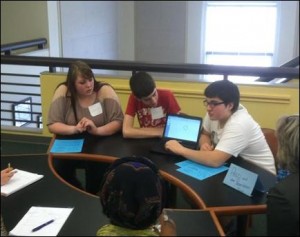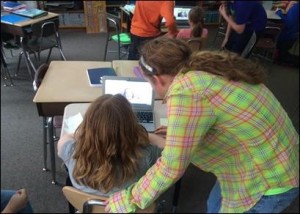

Authors: Megan Leger (Colton-Pierrepont Central School) & Marta Albert (SUNY Potsdam)
Who you gonna call? Origins of TechBusters
Our roundtable session focused on TechBusters, an elective course for students in grades 7-12 in a rural, northern New York State public school. The school initiated a 1:1 laptop program using Google Chromebooks in the fall of 2011. Session co-presenter Megan Leger, a secondary social studies teacher who also holds certification in adolescent literacy, developed TechBusters when the need for differentiated support for effective integration of the laptops grew clear (rollout occurred in stages, with high schoolers back to grade 4 students receiving laptops, and students of early grades using tablets within classrooms). Having successfully transformed her traditional, paper-based pedagogy to a (nearly) paperless environment, Megan has assumed a leadership role in her school, helping colleagues to figure out ways to ‘go tech’ to complement and enhance teaching in their subject areas.
We (Megan and session co-presenter Marta Albert) met when Megan was a student in Marta’s “Teaching Writing” and “Technology in Literacy Education” graduate courses at nearby SUNY Potsdam. We discovered a shared interest in addressing the literacy struggles of older youth, and we connected around our desire to promote “college knowledge” (Conley, 2007) among rural youth. Despite the unusual circumstance of our location — a sparsely-populated county with four colleges located within a ten-mile radius of Megan’s school — both statewide data and local, anecdotal reports suggest uneven patterns of college attendance.
For example, in 2010 nearly 25% of graduates of our region planned to enter the workforce, military, or ‘other’ upon graduation (NYS Education Dept., 2010). While this figure is comparable to other rural regions of the state, and it obviously also suggests college-going intentions of about 75%, it is distressing in light of consistently high unemployment rates of our area, which hover around 10%. Low per-capita income, high housing costs, and lack of a transportation infrastructure all affect rural young people’s capacity to find good jobs in our region without further education after high school. Limited knowledge about what is required to plan, and be prepared academically, for college affects many youth as they move through high school, make choices about courses and co-curricular activities to pursue, and consolidate a sense of their future aspirations and identities.
With all of these factors and student needs in mind, and with a mutual passion for tinkering with educational technology at the heart of our ongoing conversations about improving adolescent literacy, it struck us as a natural fit to link the emerging student leaders of Megan’s TechBusters class with Marta’s literacy education students at the college.
Authentic Digital Citizenship Within and Across Institutions
The high school course connects literacy, technology, and leadership development around the core theme of digital citizenship. Curricular strands range from ongoing exploration of the ethics embedded in digital literacy learning and use, to the development of expertise with specific apps and tools, in order to create sample materials and texts for peers, younger students, and teachers. TechBusters have provided tech support for primary students, their peers, as well as adults. Using “authentic” audiences (anyone other than Megan, the course teacher), students are forced to think and learn differently. Megan has examined students taking their works and reworking them to meet the needs of their audience participants. In doing so, students gain expertise using various tools while they simultaneously engage in critical reflection about how these tools mediate learning and development — their own and others’.
At the college level, we have pursued similar themes in a variety of contexts, sharing the work of TechBusters with fellow pre-service teachers, educators, and our high school partners. For example, we have used the collaboration features of Google tools to position college students as literacy mentors for high schoolers. As the high school students developed “Internet Safety” presentations that they taught to younger students, they shared drafts with the college students, seeking advice about how to improve their work to address the needs and interests of specific audiences (early elementary, later elementary, parents, etc.), and create messages with visual appeal and coherence.
Use of the comment feature within Google Presentations provided graduate students in literacy education with a concrete opportunity to coach the secondary students and provide feedback about revising strategies. This authentic context of learning about youth writing development was important for the college partners, as it allowed them to practice new forms of strategic, generative response to writing and to witness the growth of student writing as the presentations evolved online.
Flipping Professional Development
A dynamic, two-way relationship has characterized our connection in TechBusters since its genesis, perhaps best illustrated in our approach to professional development where we ‘flip’ the PD narrative, placing young people and secondary educators in the role of experts, and college counterparts as novices. We suspect educators at the college level who are exploring technology-pedagogy relationships experience a wide range of attitudes and emotions, similar to their K-12 counterparts: interest and a desire to learn; a strong need for support to build self-efficacy; and an expectation of institutional leadership (Ertmer and Ottenbreit-Leftwich, 2010; Howley, Wood, and Hough, 2011).
To address our hunch head-on, we have brought the emerging workshop expertise of TechBusters youth to the rescue. Student designed-and-delivered brown-bag and in-class workshops have enabled faculty and pre-service teachers to learn about technology integration practices, and the meanings students make of them, through hands-on experiences. Participant comments following the sessions we have sponsored to date encourage us to expand this element of TechBusters.
To be clear, in bringing our student and teaching colleagues together, our goal has not been to convert educational tech skeptics to true believers. In fact, in each session there has been an undercurrent of shared skepticism among some youth and college participants as they discuss and debate the pervasiveness of technology in our everyday lives, the ways in which such pervasiveness might negatively challenge or even erode rural lifeways, and the uneven access to technology that is common in our geographically sprawling county.
Yet we see these conversations as an illustration of the success of our flipped PD model, showing the importance and value of the new kinds of intentional, cross-generational connections we have sought to establish. Such connections foster TechBuster student knowledge and build confidence in traditional and digital literacy practices. They also provide students with exposure to a college setting, and position them as knowledgeable, or more accurately, instrumental civic partners in our collective effort to examine and critique technology in all facets of our learning lives.
Conclusion
We hope that TechBusters reinforces for all participants many of the values and practices central to the rhetoric of effective 21st century learning environments, particularly those ideas focused on the need for educators to use technology in ways that will engender active learning, craft venues that encourage students to develop autonomy, and promote high-level collaborations (Moller & Reitzes, 2011).
Significantly, by flipping PD, our joint activity helps flatten and distribute authority, promoting knowledge development for all through interaction and shared negotiation of meanings. We look forward to continuing to explore how our effort can best enrich the literacies of rural youth, and assist literacy educators in developing tech-focused curricula that engage diverse rural learners. For more information about TechBusters, please visit our website.
References
Conley, D. T. (2007). Redefining college readiness. Eugene, OR: Educational Policy Improvement Center. Retrieved from http://www.aypf.org/documents/RedefiningCollegeReadiness.pdf.
Ertmer, P. & Ottenbreit-Leftwich, A. (2010). Teacher technology change: How knowledge, confidence, beliefs, and culture intersect. Journal of Research on Technology in Education, 42(3), pp. 255-284.
Howley, A., Wood, L., & Hough, B. (2011). Rural elementary school teachers’ technology integration. Journal of Research in Rural Education, 26(9). Retrieved from http://jrre.psu.edu/articles/26-9.pdf.
Moeller, B. & Reitzes, T. (2011). Integrating technology with student-centered learning. Quincy, MA: Nellie Mae Education Foundation. Retrieved from http://www.nmefoundation.org/resources/personalization/integrating-technology-with-student-centered-learn
New York State Education Department Information and Reporting Services (2010). Distribution of 2009-10 high school graduates: New York State. Retrieved from http://www.p12.nysed.gov/irs/statistics/hsgrads/2010/table3.pdf



